
Welcome to part five of my colossal interview with Sam Kieth (parts one through four, here). In this final part, we begin with the standard fare of discussing current projects. Then, we delightfully digress into a conversation about Sam’s parents, his views on spirituality, his personal creative process, and much more. Plus, there’s a special section at the end of the article with exclusive photos of never before seen Sam-art! Also, I had mentioned in part four that I would put details for a contest in the final part of this interview, but I promised Sam (and myself) that I would fit the remainder of the interview into this fifth and final part. Hence, for the sake of brevity (within the intro, of course), I’m asking that you send a blank message with the title “Sam Contest” to the e-mail at the bottom of the article. From there, I’ll give you all the details about the contest and how to win. As of this week, I’ve added the Four Women mini-series to the grand prize package. To see the full list of prizes, check out the beginning of part four. NOTE: This interview was conducted long before IDW announced that Sam would be working with Steve Niles on an ongoing 30 Days of Night book (coming October 2011). All references to 30 Days of Night concern Sam’s current mini-series with Joe R. Lansdale.
Comic Attack: Tell us about your experience of doing the artwork for 30 Days of Night: Night, Again.
Sam Kieth: It’s quite a bit of gore. I’m actually working on a children’s book just for myself on the side because it’s probably a nice balance to the gore (laughs). I get to draw soft fuzzy pink things and cute animals. You’ve seen my stuff. I can be just as gory as the next guy. I just have to balance it out with some other part of me. You know the drill with vampires. They have to have blood running down their mouths. The colorist is a guy named Jay Fotos, and I told him I’m gonna be doing most of the blood in black, and I would appreciate it if he could turn it into red for me. Because, getting older, it’s just kind of strange to be drawing dozens of bloody vampires coming across the horizon.
CA: In The Maxx, there was that scene of Julie cutting Mr. Gone’s head off. Instead of actually showing the decapitation, you chose another approach, and did the cut scene of her brushing a doll’s hair until the head fell off. That image stuck with me, and I feel that worked really well.
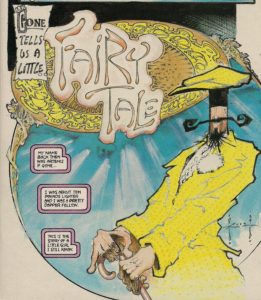
SK: Well, I don’t know if a horror book is where you wanna pull back and use a lot of symbolism. Horror fans really want to get their fix. I tell you one thing, people will either love this book or hate it. It won’t be just another vampire book. Because I stick out all over, ya know. I mean, there’s a sequence in the middle of the book where there’s a flashback, and I decided to draw it in a child-like way. It’s similar to that scene in The Maxx (Issue #10), where Julie remembers everything as a kid, and there’s a flashback with Mr. Gone. That was drawn in a child-like way as well. The flashback in 30 Days of Night was just a couple of pages. I thought they were gonna want me to redraw it, because it seemed just too bizarre for a vampire book. I was sure they were gonna throw a fit, but they loved it! They said, “This is great! You do the flashbacks in a different style!” It was a grueling scene where these human beings had to eat dead bodies. I thought, I could draw it realistically, but it’s more horrifying if I draw it in a simple child-like way (laughs). In the scene, there’s a group of people and they say, “Well, we set out over the ice, and then we buried the dead.” In the next panel, there’s a happy little drawing of them smiling as they’re going across the ice, and they say, “Then, we realized we needed something to eat.” (laughs) After that, they turn around and go back. There’s all of these little bags with body parts sticking out of them. To me, drawing that scene innocently, just for a couple of pages, made it more horrifying. That’s pretty minor. As for the rest of the art, it’s pretty easy for me to go into Arkham Asylum/Batman/Joker mode and do that stuff. I said to the writer of the book …(Sam digresses)…Do you remember that Bubba Ho-Tep movie? Did you ever see that?
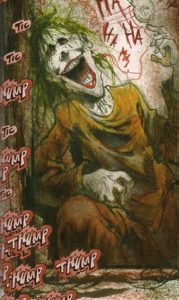
CA: Heck yeah! Great movie.
SK: Yeah, I love that movie. Anyway, Joe R. Lansdale wrote the short story that Bubba Ho-Tep was based on, and he’s writing this book. So, it’s a good story. It’s one of the things that hooked me. He sent me a proposal, and I thought it was one of the best proposals that I had ever read by anyone. I said, this is great, but there is a main character in the book…this is a horror book…should I give a shit about her (laughs), or should I write her off because she’s gonna be more fodder for vampires. He wrote back a three line reply: “Whether or not she survives, you should give a shit about her. You should care about this character. She’s going to valiantly try to face these things she’s been avoiding the whole book.” So, he’s an interesting guy who can write these down and dirty characters. He has a lot of strong women characters. Which, of course, appeals to me. He has a way of writing really grueling things that I probably wouldn’t write, but then turning them around and making us really care about the story. The biggest thing is just that, when you’re drawing someone else’s story, in some ways you can draw on autopilot. Because they’re doing the work, but in other ways, you kinda have to follow their rhythm. I always think it makes me a better story-teller when I work with another writer, it also makes me really yearn to go off and do something on my own when I see the process backwards. Because I just draw something, and then work it into a story. Jay Fotos is really saving my butt on this. I was nervous about how it was gonna look. He kept saying, “Do you have any notes?” I said, no man, just keep running with it.

CA: What projects are you currently working on besides 30 days of Night: Night, Again?
SK: After this, I’m doing an Aliens series with John Layman for Dark Horse. It’ll be the first time I’ve done Aliens in I don’t know how many years [As of June, it’s been eleven years since Aliens: Earth War]. There’s still a Batman series with Bruce Jones that never came out, and I’m working on a Demon book with Scott Ian.
CA: Which Batman book is it that hasn’t been published yet?
SK: It hasn’t even come out, and was written like a year and a half ago. It’s completely drawn and lettered, and Bruce Jones wrote it. It’s like an Alice in Wonderland story [featuring the Mad Hatter, of course]. It’s Batman meets Alice in Wonderland. It’s strange, because it’ll be the last Batman story that comes out, but it was finished before Arkham Asylum; Madness, Batman: Secrets, and Batman: Confidential. All those were done after this story. So, I wonder if people will say, “Wow, this is really great!”, or “Boy, it really fell apart at the end.” (laughs) Maybe they’ll say that it fell apart in the beginning.
CA: Why hasn’t it been published yet?
SK: (groans) I don’t know. DC Comics went through a bunch of changes recently, and they’re reorganizing things. I know it will eventually come out, but this happens with some of the big companies, where they’ll sit on a bunch of things. It used to be even more true in the past. At one point, I had like four books that were finished, but unpublished. To be fair to them, if they release too many of my Batman books in a row, it looks like I’m hogging too much of the character. They want to spread it out. Which makes sense. If not, people would say, “Sam Kieth does Batman. What’s he doing? Oh another Batman thing (makes snoring noise).” Now it’ll probably be even better and fresher when it’s finally published, because I’m doing all these other things. It’s sitting in their vault, and it’ll come out some day. In the meantime, there’s plenty of other stuff (deep breath) to keep me going. It probably wouldn’t hurt if I branched out and did something for DC that wasn’t Batman (laughs)! Because when you do too much of one thing people are like, “You’re doing that again?” If you do another character, they’re like, “Oh, you’re doing a vampire book? That’s different.”, or “Oh, you’re doing Aliens again? How’s it gonna be different from the other Aliens series you did?” It kind of wakes people up if you can seem the same but different.

CA: What other DC character would you like to work on (besides the Demon)?
SK: People usually think this is either a really good idea or a really bad idea. A lot of people have asked what my Superman would look like. I think parents would probably be horrified by the idea. I would pretty much dirty him up.
CA: If nothing else, it would be extremely controversial.
SK: Yeah, Superman pretty much needs to be…I mean…people have a lot of a expectations about Superman. There are certain characters that almost seem to have…like Swamp Thing is one of those. It was intimidating enough with the whole Bernie Wrightson Swamp Thing. But then after Alan Moore went and did it, I don’t wanna try and live up to the Alan Moore Swamp Thing stories. And then there’s The Sandman. People don’t even wanna touch The Sandman right now.
CA: I would really love to see you do a Swamp Thing story. It seems like it would be a perfect fit.
SK: Yeah, but see…what Swamp Thing book would it be? Would it be a Bernie Wrightson Swamp Thing? Would it be an Alan Moore Swamp Thing?
CA: It would be a Sam Kieth Swamp Thing.
SK: Right, but that’s a whole different animal.
CA: That’s what would be so awesome about it.
SK: John Layman and I were talking about how to come at something that people have already seen. Some would view it as setting yourself up for failure. Like you say, you’d have to be yourself. If not, people would say, “Sam’s doing Bernie Wrightson poorly…again. Sam’s trying to go crazy and do all this moss in an Alan Moore’s Swamp Thing story.” The challenge is finding a character that hasn’t been chewed to death.
CA: There’s just so many opportunities for texture in a book like Swamp Thing.
SK: Yeah. We’ll see. I’m hopeful, but I’m a realist (laughs). There’s a lot of politics behind any character you decide to use.

CA: OK, I have a heavy question for you. The Maxx explored aspects of spirituality and psychology. I was curious about your personal spirituality and how it effects the stories that you write.
SK: That’s interesting. I don’t think I’ve ever been asked that before. Well, I guess what I can talk about is…um…(pauses)…yeah you’re right. This is a heavy question (laughs). It’s interesting that you asked that. Everybody takes from whatever I do, in this case The Maxx, something different. To some people, that’s a very surreal book. To some people, it’s a funny book. Most people pretty much agree, it’s a bizarre and strange book. It’s interesting that you picked up on, or were curious about the spiritual side of it. So, before I answer that, I just want to ask you, what things jumped out at you as being spiritual in The Maxx.
CA: The concept of spirit animals and totems.
SK: Right. Which is kind of hearkening back to that whole aboriginal and Pacific Northwest Native American spirit animal. Many of the Native American tribes had varying totem animals. I guess my whole upbringing was with my Mom in the sixties. People were blending things together that maybe didn’t have anything to do with each other. People were reading books on Eastern mysticism, Native American Shamanism, New Age books, and all sorts of things that my mother exposed me to. Later, she was horribly worried that she had ruined me by exposing me to so many different interests (laughs). I never really landed on any one of them. I think those are the things that got kind of mixed up into a big gumbo soup in The Maxx. It’s a little bit of psychology and a little bit of this mock aboriginal Australia universe. Though, it’s not really Australia at all, because it’s an imaginary outback. It gave me a place to touch on things, but not land on any one thing. I feel like, what people call spirituality, is such a personal thing. The more specific my opinions, the worse piece of work it is. Frankly, I don’t really have any opinions. If I do, the implication is, that I know something that somebody else doesn’t, and then I’m lecturing. I know squat. I know nothing. So, I think it’s more interesting to have a series of characters that are going through things and to see what they make of the world. To see what conclusions they draw. They want something. Then, there’s this inner obstacle to them getting it. So they turn to mythology, psychology, spirituality, or maybe they decide there’s no god at all.

CA: I can say, having Native American roots, I especially identify with the totem animal aspect of the story in The Maxx.
SK: Yeah, I do too. I have a whole Oni book coming out that deals with this girl, Nola. She has to struggle with these violent and inappropriate urges inside of herself, and she’s visited by ravens. The Raven from the Pacific Northwest Inuit tribes version of the raven. Which is like this whimsical creator of everything. It basically comes along and guides her back to some balance between selflessness and the violent impulses inside of her. It’s kind of like this, I don’t wanna say spiritual quest, because she’s basically an agnostic. It’s another one of those stories that if I do the job correctly, regardless of whatever you believe, you’ll be more interested in the things she’s struggling with than what dogma she follows. It seems like the best stories, touch on these things, but don’t get their feet stuck in the mud too badly, ya know.
CA: I agree. Adhering too strongly to a specific belief in story-telling, without leaving room for interpretation, can easily become a vehicle to preach your personal beliefs.
SK: For me, it’s strange, but I can read Kurt Vonnegut or listen to George Carlin, two people that are by obvious reading, clearly atheists and have absurdest world views. But many of the subjects they touch on, seem to me, as close to a philosophy that embodies, if not spirituality, a fresh take on things. To me, it seems almost negotiable, but to other people it seems sacrilegious. I remember a screen writing professor from a class that I took when I was a teenager saying that Kurt Vonnegut saw the world as a series of random events and abhorred the idea of structure. I think his novels are very structured. The actual events in them are non-linear, but there’s a story being told. It just happens to jump around a bit, but it’s still pretty traditional stories in content, even if the form is kinda bizarre.
CA: In the Kieth: The Sketchbooks Vol. 2, you talked about doing a series of Tarot cards for a Belgian collector named Carl Wyckaert. I would love to hear the full story behind that.

SK: (laughs) Ya know, Josh, I wish I had a great story. Carl and I had talked about doing them. I said to him, when I was younger I had studied the Tarot, but I actually wasn’t sure that I would be able to do justice to the cards. I had previous experiences with them, and he wanted someone that would bring something fresh. Whatever he felt about the card, he would write on the card. He would actually work that dialog about that experience of working on them into the card. I said, well, I don’t see it that way, because I actually have associations with the cards. I’ve studied the meaning behind them. We finally agreed that I would do them, if I had total freedom to say whatever I want. So, on one of the cards, I said that he was being a real butthead about telling me what to do with the cards. When I wrote that, I wondered if he was gonna be pissed off. I thought, well, it’s honestly how I felt (laughs). He wanted me to honestly talk about the cards. So, I said, Carl was being a real butthead when he told me about these cards, and I wrote that on the card. He loved it. In fact, he asked me not to burn that card and asked if he could have it. I said, but I called you a butthead, and he said “I don’t care. I’m very flattered that you mentioned me in this card, and I’m just vain enough to want it.” I thought it was very nice that he spared that one from burning. I said, well, it does mention you, and you should definitely have it. If you change your mind later and you wanna burn it yourself, you can. To me, it was a pivotal point, because it kind of set me off on this thing of doing more and more paintings for my own fulfillment, and it opened up this door of painting and drawing things that actually have no earthly purpose other than just to amuse myself. It’s just real rich therapy, and it’s very cathartic to do that. Everything involved in comic book story telling has an absolute reason to be there. Every panel has a point. So, it’s nice to fill sketchbooks and paintings with things that there’s no blessed reason for. I’ll just say, I wonder what pops out of me today?…aw it’s crap!…OK, throw it away…oh, this is kinda interesting…oh hey, dig that out of the garbage, I think I can make that into something.
Right now, I’m looking at a drawing of a vampire’s face…a girl’s face…I said nope, and I scratched it out, and on the right, I drew another one and said, OK, this one’s fine for a page in the book. So, I showed it to IDW, and I said, what do you think about this as the cover? They said, “Hey that’s great! Use that as the cover instead of an interior page. By the way, we need a new page twenty-two.” So, I got myself a cover, but now, I’m behind a page.

I never know when I sit down and draw, what’s gonna come out. It’s skill that allows someone to draw something when they don’t feel like drawing, but it’s talent where you luck out. You can’t rely on talent. There’s no guarantee that on Monday morning at nine o’clock that you’re gonna feel talented. You may feel like crap that day. You may wonder why you’re drawing a specific panel for a comic. You may think, “What does this have to do with my life? I could give a shit about this. Later, in the context of the story, I’ll be glad I drew it, but right now, it’s meaningless.” Once in a while, everything comes to life, and you think, “It’s really flowing out of me. Today is a really good day to do those panels that really matter and they’re really gonna pay off. It’s time to redraw something that looks like crap and give it a good chance.” I’m lucky if I get two or three of those days in a week. The rest of the time, I’m like a carpenter building crap, ya know…hammering stuff together. It’s damn frustrating to try and do things on time and put them in little boxes and have them not suck (laughs). It feels like when you create something, and this is anyone…anyone who paints, puts their hands on clay, or any of the art forms where you are directly involved – no slide to people that do movies or are involved in a process where they have multiple assistants – when you are directly doing the piece of work yourself and you’re supposed to create something, it’s very much like you’re stuck in dark room, and you’re supposed to make something in the dark that you can’t see. Then suddenly someone flips on the lights, and there’s a hundred people all staring at you in the room and checking out what you’ve made. If it’s really good, you take a bow and act like you knew what the hell you were making. If it sucks, they throw tomatoes, and you dodge them. If you say, “Yes, I did that. Turn out the lights, and I’ll be glad to do it again!” You’re a liar! Because you had no clue what you were doing at the time. The only thing I’ve learned from that is, that you’re gonna have to work in the dark when you create something. There is a slowly learned skill of reaching out in the dark and touching something where you have a sense that – you may not be able to control what it ultimately looks like or how it’s received – but you can feel it. You might not be able to see it, but you can have a sense of its shape and visualize it. To me, that’s the only true connection that somebody has with their art. The interior feeling of, “OK this feels good to me. I could actually get it finished, put it off in my studio. Then turn around, go upstairs out of my studio and die. The next morning someone would find it. They’ll make whatever they can of it, but I’ve done the best I can from my end.” That’s why I always say, it’s none of our business what the artists say. All the quips we have…this interview…everything we say is meaningless. We make our statement when we draw something or when we write it. People will make their own determinations.
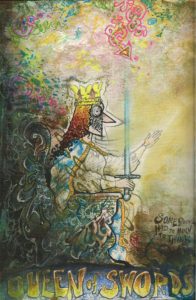
CA: You mentioned burning the tarot cards; I didn’t quite understand that. Could you elaborate on the reasoning behind that?
SK: There’s a whole Tibetan thing with sand painting, where the monks will spend months building a painting out of sand, and after they’re finished, they’ll turn it over and destroy it. To me, that all goes back to the fact that eventually, everything is landfill. Everything goes back into the Earth. You can see it romantically or New Age or just sterile and cold. But I always feel strangely warm and comforted that in the end it won’t go into the hands of some collector overseas who wants to get it in a gallery. Some of it just goes back into the ground. Like me. Like I will some day. Like all of us will. It’s a matter of not taking things so seriously or putting them so much on the shelf that they feel divided from the natural cycle of decay and disintegration. Which is probably pretty depressing to a lot of people.
CA: You said earlier that the Tarot cards where a turning point for you as an artist. Is that when you began doing your abstract paintings?
SK: They really started back with my father. He wanted to be a painter when he was younger. Like with anyone, it was a struggle to get anyone to accept his art. He was a figurative artist and a portrait painter, but he also did abstracts. I just grew up in a house seeing abstract paintings. It seemed normal to me that people could do that. I’d always been interested in abstracts and post modern art. So, the seeds were always kinda there, but it just seems like…basically when I started My inner Bimbo, Josh [Hagler] (a contributing artist on My Inner Bimbo) discovered that I would work large and with different media. I just discovered that if I didn’t occasionally paint a panel, I was just gonna go crazy, and blow my brains out. I have to paint something. Painting actually gives me enough energy to draw another fifteen or twenty pages. The thing with painting is, it’s enough to propel me into a whole bunch of other black and white work. Then I realized it doesn’t have to be in comics. It could be anything. It’s almost like therapy, ya know…therapy for complete idiots (laughs).

CA: In Kieth: The Sketchbooks Vol. 2, you mentioned that you drew an entire comic with your left hand, and you challenged the reader to guess which issue it was. Well, I couldn’t figure it out. So, which one was it?
SK: (hard laugh) Boy, I didn’t think anyone would ever call me on that. That’s pretty good, Josh (laughs). It was a couple of books. One was this Batman book that hasn’t been released with Bruce Jones. The other one was an issue of The Maxx that I never printed. It’s that long lost Maxx issue. The one that I did before I decided to cancel the book. I did it with my left hand and had forgotten about it. I discovered it a while back, and I mentioned it in the sketchbook. Then I realized, no one had seen that issue of The Maxx (laughs). I thought when I wrote that in the sketchbook, that the Batman book would be out and people would have seen that. Of course they haven’t seen it yet. So, the reality is, nobody has seen them yet. I’m such an undisciplined artist with my right hand, there’s really not as big a change as you would think. Sadly, when I get out the Sharpie, a lot of bad art can come out of the left or right hand. It’s pretty much an equal opportunity assault on the eyes.
[Sam shares some final thoughts before saying goodbye]
SK: Josh, everything I do is a story. It’s never just a drawing. There’s always some god-awful story behind it, and stupidly, I’m always trying to weave it together into some grand universe. Sometimes it works. Sometimes it doesn’t. People can always go to their favorite sweet spots and say, “Man I really love number seven or number thirteen.”, or, “I really love this blue spot or that little brown fuzzy corner over there. Yeah, but nobody likes that prickly stuff over here.” Everyone can get their own sensibility of shape, texture, material, genre or story and say, “I like this.” My job is to chop it up into parts, and string it along. I understand the publisher’s desire to divide it into this or that. I wish I could, man. It’s just not that way in my mind. In my brain, you rip off The Maxx’s head and there’s a rabbit underneath. You rip off the rabbit’s and there’s The Trout underneath. You rip off The Trout’s head, and who knows. It’s all part of one giant dream (pauses)…that I can’t ever seem to escape from.
Here are some exclusive photos of some unseen Sam-art. The first five photos are Sam’s abstract work that we spoke about in the interview (opening commentary by Sam):
It’s very tactile. The feeling you get when you look at something that’s three-dimensional. That’s why these are not photographed at a flat angle. Because you can catch the texture of things that stand out from the canvas better when they’re shot at a forty-five degree angle. Some of them, you want people to see them in person. Some things you can’t see in a flat photograph. That’s one of the things about three dimensional art, is how to give people a sense of it without seeing it in person.
Special thanks to: Wendy Hailey, Andy Liegl, AnnaMaria White, Kristin Bomba, Stephen Huczeck, Fernado Valencia, and all the Sam-heads for their support and kind words. Of course, most importantly, thank you Sam…for everything!
Josh Jones
josh@comicattack.net

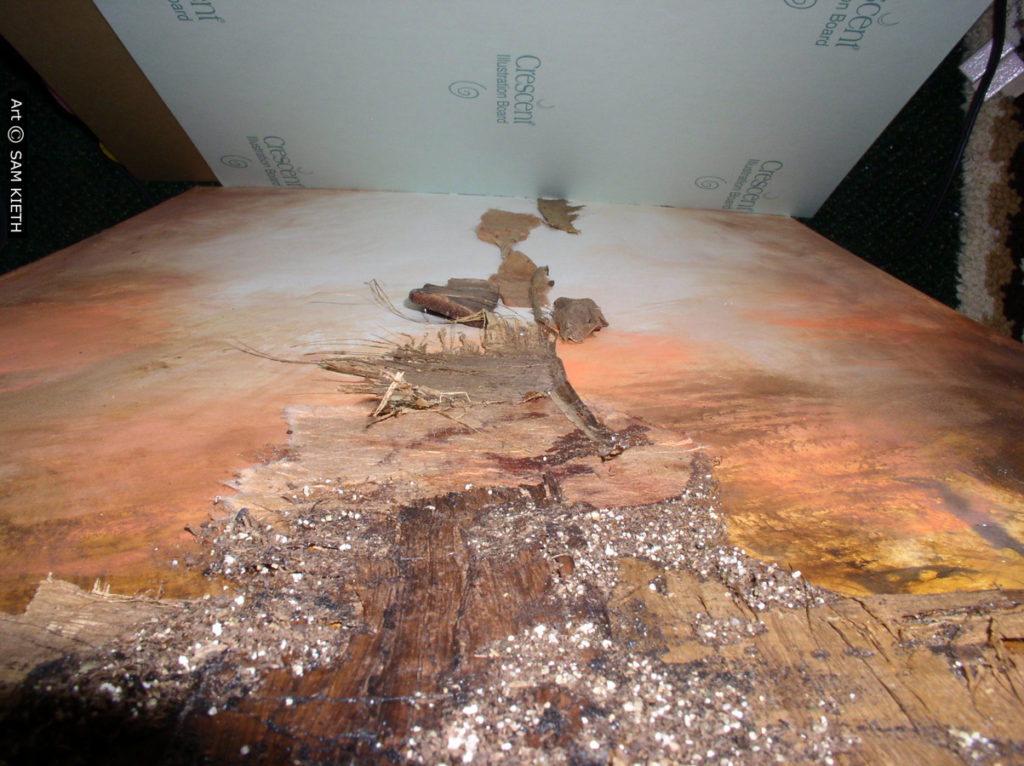



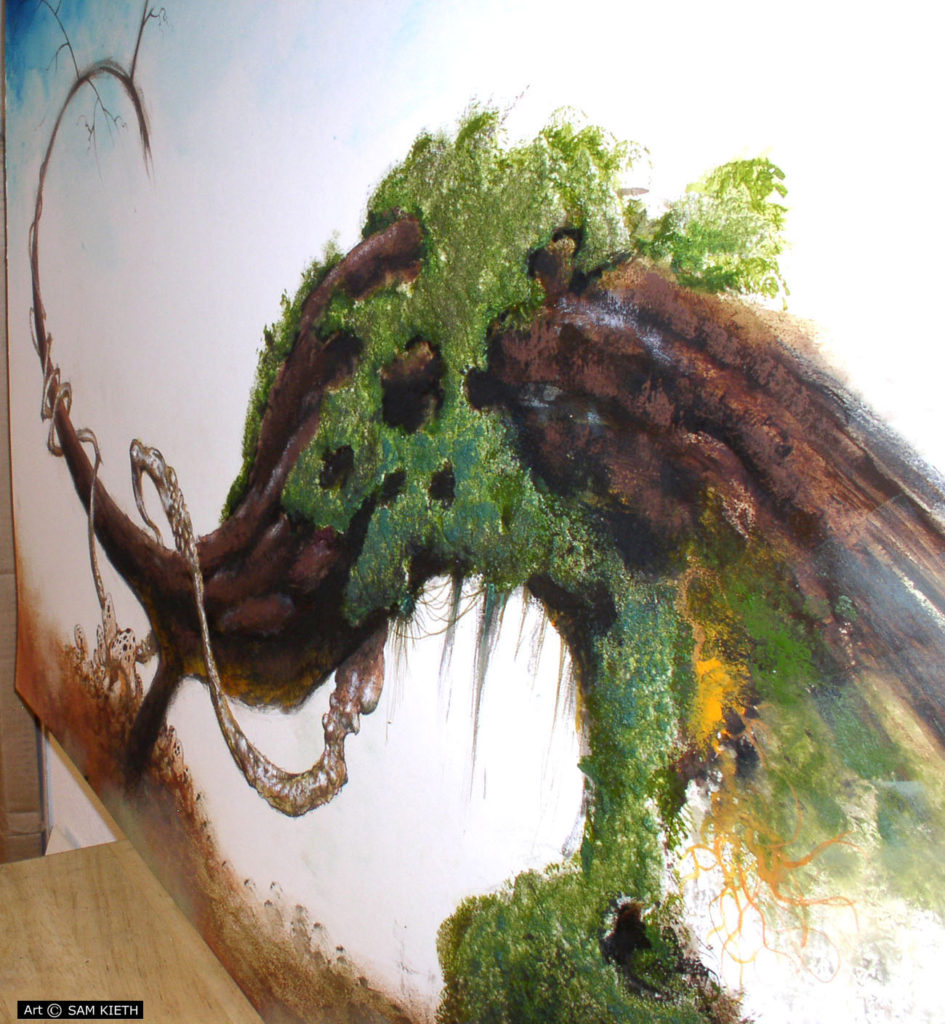

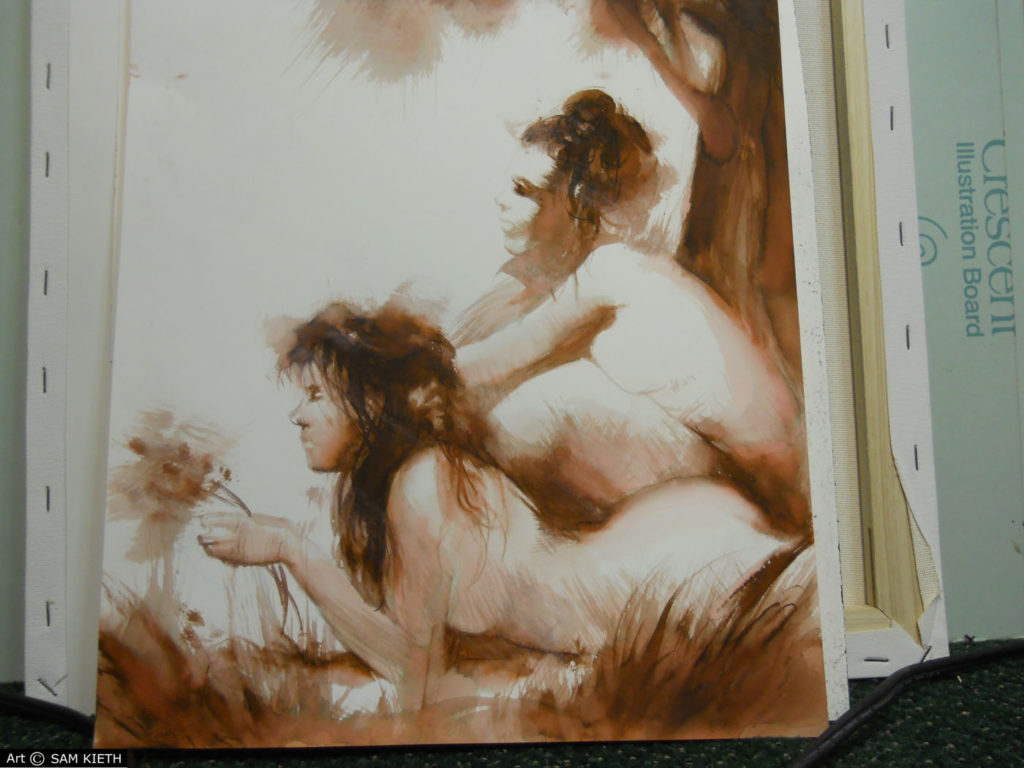
A perfect ending to a perfect interview. I have been constantly checking every week, and re-reading parts 1 – 4 over and over again. Sam is a wonderful and inspiring artist and writer, and I’m always looking forward to his work. Through these interviews, his humility, humor, and honesty come out in fresh, full force.
All the best to Sam in all of his future endeavors, and thanks to Josh, for conducting such a great interview!!!
This was an amazing interview Josh, my friend. Sam Kieth’s work has always held a very personal place in my mind and heart since I first discovered his work with ( typically ) The Maxx #1. I am happy to read such an honest interview with one of the greatest modern artists alive today. Possibly THE greatest ( in my opinion ).
The interview you conducted was spot on. You, for the most part, asked Sam every question ( and then some ) that I would have had for him. I know this sounds like a severe change of subject here but….damn…if you could get an interview this good with Erik Larsen, I would be a very very happy guy.
This was a phenomenal interview! Thank you for providing such an in-depth look to his work and self.
hey man this was an amazing interview
fantastic interview.